#Was the House of Refuge the first house in Martin County
Explore tagged Tumblr posts
Text
Historic Property Dispute Over the House Of Refuge
Historic Property Dispute Over the House Of Refuge
The once home of pioneers Hiram and Hattie Olds as viewed from Gilbert’s Bar House of Refuge after a shipwreck. Hutchinson Island, Florida. ca. 1904. Courtesy local historian Sandra Henderson Thurlow.
I learned something form my previous blog post that I think is really interesting.
See the house in the distance in the above photograph? It was the Olds’ homestead that I mentioned in my…
View On WordPress
#"Gilbert&039;s Bar House of Refuge#Deanna Thurlow#Deed to Olds historic homestead on Hutchinson Island FL#Gilbert&039;s Bar House of Refuge Home of history#Hiram and Hattie Olds#Historic photos Hutchinson Island#historic property dispute#Historic Property Dispute Over the House Of Refuge#Historic survey map Hutchinson Island#House of History#house of refuge#Hutchinson Island history#land dispute house of refuge#Property dispute#Sandra Thurlow#U.S. Government#Was the House of Refuge the first house in Martin County#What year was the House of Refuge built?
0 notes
Text
Top Hotels in Stuart, FL
Stuart is a city in and the seat of Martin County, Florida, United States. Located on Florida's Treasure Coast, Stuart is the largest of four incorporated municipalities in Martin County. This region was first settled by non-Native Americans in 1870. A US Lifesaving Station was established near Stuart on Hutchinson Island in 1875 and today, that is known as Gilbert’s Bar House of Refuge which is now on the National Register of Historic Places. People often find their way to Stuart regularly to engage in one activity or the other. The Hotels in the city of Stuart are fantastic, they render excellent service to their guests be it residents of Stuart or visitors. Should you visit this city, below are the top hotels you will find there:

Hutchinson Island Marriott Beach Resort & Marina: to locate this fantastic 4-star hotel visit 555 NE Ocean Blvd, Stuart, FL 34996, USA. It is a contemporary oceanfront hotel featuring glamorous views
Hutchinson Shores Resort & Spa: take a ride to 3793 NE Ocean Blvd, Jensen Beach, Stuart, FL 34957, USA, there, you will set your eyes on the beautiful view of this amazing 3-star hotel.
Courtyard By Marriott Stuart: head to 7615 SW Lost River Rd, Stuart, FL 34997, USA, there, you will locate this great hotel. As a guest to this 3-star hotel, you will be accessible to outdoor heated pool, free Wi-Fi and lots more.

One of the activities that attracts people’s attention into the city of Stuart is to engage in business transactions and invest in businesses operating in the city. If you need more information about them, kindly visit https://www.google.com/maps/place/ShockSocks/@27.2144547,-80.2615197,17z/data=!3m1!4b1!4m5!3m4!1s0x88dee7f6a214e1f3:0x74aaa512f14b3d9d!8m2!3d27.2144769!4d-80.259339?shorturl=1. This is as a result of the city’s thriving business environment. Thanks to Stuart FL Business Spotlight that contributes so much to make this possible. ShockSocks is a prominent member of this group.
Contact Us- ShockSocks Address: 727 NW Federal Hwy, Stuart, FL 34994 USA
Get Map Directions:-
1 note
·
View note
Text
Martin county, Florida foundation repair
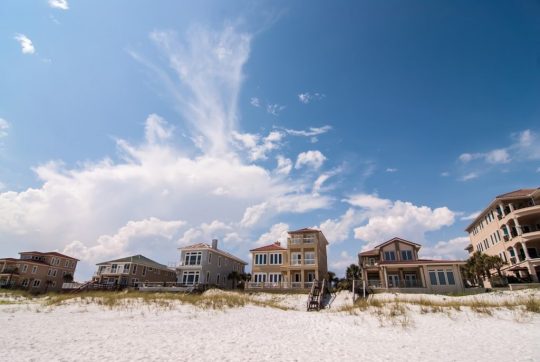
Martin county Florida
Martin County, Florida is a picturesque destination located on Florida's Treasure Coast.Boasting sunny days, white sandy beaches, and family friendly attractions, it is no surprise that this area of Florida is a popular destination for vacationers and homebuyers alike. From its many outdoor activities, to its abundance of shopping and dining experiences, there is something for everyone in Martin County.With its diverse culture and beautiful waterfront views, it is easy to see why many visitors and residents choose Martin County as their home away from home.Whether you're looking for a relaxing beach getaway, or a place to live, Martin County has something to offer everyone. In this blog post, we will explore all that Martin County has to offer and why it is an ideal location for a vacation or a permanent home.
Hurry! Fill this form to talk to a Florida foundation pro!
* indicates required First Name Last Name Email Address * Phone Number Describe briefly what the problem seems to be Marketing Permissions Please select all the ways you would like to hear from Florida Foundation Pro: Email phone You can unsubscribe at any time by clicking the link in the footer of our emails. For information about our privacy practices, please visit our website. We use Mailchimp as our marketing platform. By clicking below to subscribe, you acknowledge that your information will be transferred to Mailchimp for processing. Learn more about Mailchimp's privacy practices here. Where is Martin county in Florida and what is there to do? Martin County is located on the east coast of Florida, just north of Palm Beach County.This area is known for its beautiful beaches, stunning nature preserves, and amazing fishing and boating opportunities. Popular attractions in the area include Jensen Beach, the Martin County Zoo and Aquarium, the Elliott Museum, and the House of Refuge Museum.There are also plenty of opportunities for outdoor activities, like hiking, biking, and kayaking, as well as more relaxing activities such as shopping, dining, and spa services. Martin County is a great place to visit for a relaxing vacation or for a weekend getaway.

Should I buy a house in Martin county, FL? Martin County, FL is an excellent place to consider for your next home purchase. With its close proximity to the Atlantic Ocean, miles of beaches, and stunning views, Martin County offers a unique experience for prospective homeowners.The area is known for its low cost of living, safe and friendly neighborhoods, and solid school systems.Additionally, the county has a vibrant economy and plenty of job opportunities. With a variety of communities and housing styles to choose from, Martin County provides something for everyone.With its warm climate, natural beauty, and excellent quality of life, Martin County is an ideal place to purchase a home and build a future.What are the house foundation problems in Martin county Florida and how can they be repaired? House foundations in Martin County, Florida can be prone to problems due to the climate and soil conditions in the area.Common issues that can occur include movement of the foundation due to shifting soils, settling, and erosion. These problems can be repaired through a variety of methods, including using steel piers to replace the weight of the structure on the soil, using concrete piers to stabilize the foundation, and waterproofing the foundation to prevent water damage.Professional contractors should be consulted to assess the particular foundation damage and recommend the most appropriate repair method. Proper maintenance and monitoring of the foundation should also be carried out to ensure any future problems are identified and addressed early.In conclusion, Martin County, Florida is an excellent choice for those looking to buy a house in a safe and beautiful location. With its many attractions and activities, there is something for everyone.Despite its advantages, potential homebuyers should look into the foundations of the houses they are considering buying, as there are potential issues that need to be addressed and repaired.With the right care and maintenance, a house in Martin County, Florida can be a beautiful and safe place to call home. Read the full article
0 notes
Text
Jeremy Corbyn Budget 2017 response
Jeremy Corbyn MP, Leader of the Labour Party, responding to the Chancellor’s Budget, said:
***CHECK AGAINST DELIVERY***
Mr Deputy Speaker, this Budget has been an advertisement for just how out-of-touch this Government is with the reality of people’s lives.
Pay is now lower for most people than it was in 2010 and wages are now falling again.
Economic growth in the first three quarters of this year is the lowest since 2009 and the slowest of the major economies in the G7.
It’s a record of failure with a forecast of more. Economic growth has been revised down. Productivity growth has been revised down. Business investment revised down.
People’s wages and living standards revised down. What sort of “strong economy, fit for the future” is that?
The deficit was due to be eradicated by 2015, then 2016, then 2017, then 2020 and now 2025. They’re missing their major targets but the failed and damaging policy of austerity remains.
The number of people sleeping rough has doubled since 2010 and 120,000 children will spend this Christmas in temporary accommodation. In some parts of the country life expectancy is actually starting to fall.
The last Labour government lifted a million children out of poverty. Under this Government an extra 1 million children will be plunged into poverty by the end of this Parliament. 1.9 million pensioners and one in six are living in poverty - the worst rate in Western Europe.
Falling pay, slow growth, and rising poverty. This is what the Chancellor has the barefaced cheek to call a “strong economy”.
His predecessor said they would put the burden on “those with the broadest shoulders”. How has that turned out?
The poorest tenth of households will lose about 10 per cent of their income by 2022 while the richest will lose just 1 per cent.
So much for “tackling burning injustices”. This Government is tossing fuel on the fire.
Personal debt levels are rising and 8.3 million people are over-indebted. If he wants to help people out of debt, he should back Labour’s policy for a Real Living Wage of £10 per hour by 2020.
And with working class young people now leaving university with £57,000 of debt - because this Government trebled tuition fees - this Government’s new policy to win over young people is to keep fees at £9,250.
But that is just one of a multitude of injustices presided over by this Government. Another is Universal Credit, which Labour has called on ministers to pause and fix.
That’s the view of this House. It’s the verdict of those on the frontline with evidence showing food bank use increases 30 per cent where Universal Credit is rolled out.
And the benches opposite should listen to Martin’s experience, a full-time worker on the minimum wage, he says: “I get paid four weekly meaning that my pay date is different each month”, because of that, under the UC system he was paid twice in a month and deemed to have earned too much so his UC was cut off. He goes on: “This led me into rent arrears and I had to use a food bank for the first time in my life”.
This Chancellor’s solution to a failing system causing more debt; is to offer a loan. And the six week wait, with 20 per cent waiting even longer, becomes a five week wait.
This system has been run down by £3 billion cuts to Work Allowances, the two-child limit and the perverse ‘rape clause’ - and caused evictions because housing benefit isn’t paid direct to the landlord.
So I say to the Chancellor: put this broken system on hold, so it can be fixed, and keep a million more children out of poverty.
For years we have had the rhetoric of a “long-term economic plan” that never meets its targets; when what all too many are experiencing is long-term economic pain.
And the hardest hit are disabled people, single parents and women.
So it is disappointing the Chancellor did not back the campaign of my Hon Friend for Brent Central, Dawn Butler, to end period poverty.
The Conservative manifesto has now been shredded and some ministers opposite have since put forward decent proposals, several conspicuously borrowed from the Labour manifesto.
Let me tell the Chancellor, as socialists we are happy to share.
The Communities Secretary called for £50 billion of borrowing to invest in housebuilding. Presumably the Prime Minister slapped him down for wanting to “bankrupt Britain”.
The Health Secretary has said the pay cap is over but where is the money to fund a pay rise? The Chancellor hasn’t been clear today, not for NHS workers nor for our police, firefighters, teachers or teaching assistants, bin collectors, tax collectors or our armed forces personnel.
Will the Chancellor listen to Claire? She says, “My Mum works for the NHS. She goes above and beyond for her patients. Why does the Government think it’s ok to under pay, over stress and underappreciate all that work?”
The NHS Chief Executive says “the budget for the NHS next year is well short of what is currently needed”.
The Health Secretary said in 2015 he would fund another 5,000 GPs, but in the last year we have 1,200 fewer GPs. We’ve lost community nurses. We’ve lost mental health nurses.
The Chancellor promised £10 billion in 2015 but delivered only £4.5 billion so we’ll wait for the small print on today’s announcement. It certainly falls well short of the £6 billion Labour would have delivered.
Over a million of our elderly aren’t receiving the care they need. Over £6 billion will have been cut from social care budgets by March next year.
Our schools will be 5 per cent worse off by 2019 despite the Conservative manifesto promising that no school would be worse off.
5,000 head teachers from 25 counties wrote to the Chancellor, saying “we are simply asking for the money that is being taken out of the system to be returned”.
Robert wrote to me saying, “As a senior science technician my pay has been reduced by over 30 per cent. I’ve seen massive cuts at my school. Good teachers and support staff leave“.
According to this Government, 5,000 head teachers are wrong. Robert is wrong. The IFS is wrong.
Councils are warning that services for vulnerable children are under more demand than ever, yet have a £2 billion shortfall. Local councils will have lost nearly 80 per cent in direct funding by 2020.
In reality, across the country this means women’s refuges closing, youth centres closing, libraries closing, museums closing.
But compassion can cost very little and just £10 million is needed to establish the child funeral fund campaigned for by my hon friend for Swansea East, Carolyn Harris.
Under this Government there are 20,000 fewer police officers. And another 6,000 community support officers, and 11,000 Fire Service staff have been cut too.
Our communities cannot be kept safe on the cheap.
Tammy explains how this has affected her: “our police presence has been taken away meaning increasing crime. As a single parent I no longer feel safe in my own village, particularly after dark.”
Mr Deputy Speaker, five and a half million workers earn less than the living wage, a million more than just five years ago.
And the Chancellor can’t even see 1.4 million unemployed people.
There is a crisis of low pay and insecure work, affecting 1 in 4 women, and 1 in 6 men, a record 7.4 million people in working households in poverty.
If we want workers earning better pay, less dependent on in-work benefits, we need to strengthen trade unions. the most effective means to boost workers’ pay.
Instead this Government weakened trade unions and introduced Employment Tribunal fees - now scrapped thanks to Unison’s legal victory.
And Mr Deputy Speaker, why didn’t the Chancellor take the opportunity to make two changes to control debt?
Firstly, to cap credit card debt so that nobody pays back more than they borrowed.
And secondly, to stop credit card companies increasing people’s credit limit without their say so.
Debt is being racked up because this Government is weak on those who exploit people: the rail companies hiking fares above inflation year-on-year, the water companies and the energy suppliers.
During the general election it promised an energy cap that would benefit "around 17 million families on standard variable tariffs". But every bill tells millions of families the Government has broken its promise.
And with £10 billion in housing benefit going into the pockets of private landlords every year, housing is a key factor in driving up the welfare bill.
With this Government delivering the worst rate of housebuilding since the 1920s and a quarter of a million fewer council homes, any commitment is welcome.
But we’ve been here before. The Government promised 200,000 starter homes three years ago and not a single one has been built.
We need a large scale public house building programme, not this Government’s accounting tricks and empty promises.
We back the abolition of stamp duty for first-time buyers because it was another Labour policy at the election, not a Tory one.
It’s this Government’s continual preference for spin over substance that means, across this country, the words “Northern Powerhouse” and “Midlands Engine” are now met with derision.
Yorkshire and Humber gets only one-tenth of the transport investment per head given to London.
And Government figures show that every region in the north of England has seen a fall in spending on services since 2012.
The Midlands, East and West, is receiving less than 8 per cent of total transport infrastructure investment, compared with over 50 per cent going to London.
In the East and West Midlands 1 in 4 workers are paid less than the living wage. So much for the ‘Midlands Engine’.
Re-announced funding for the Transpennine rail route won’t cut it and today’s other announcements won’t redress the balance.
Combined with counterproductive austerity, this lack of investment has consequences in sluggish growth and shrinking pay packets, and public investment has virtually halved.
Under this Government, the UK has the lowest rate of public investment in the G7, but it is now investing in driverless cars after months of road-testing back seat driving in government.
By moving from RPI to CPI indexation on business rates the Chancellor has adopted another Labour policy, but why don’t they go further and adopt Labour’s entire business rates pledges including exempting plant and machinery and annual revaluation of business rates.
Nowhere has that been more evident than over Brexit.
Following round after round of fruitless Brexit negotiations the Brexit Secretary has been shunted out for the Prime Minister who has got no further.
Every major business organisation has written to the Government telling them to pull their finger out.
Businesses are delaying investment decisions, but if this Government doesn’t get its act together soon they will be taking relocation decisions.
Crashing out with ‘No deal’ and turning Britain into a tin-pot tax haven will damage people’s jobs and living standards, serving only a wealthy few.
It’s not as if this Government isn’t doing its best to protect tax havens and their clients in the meantime.
The Paradise papers have again exposed how a super-rich elite is allowed to get away with dodging taxes.
This Government has opposed measure after measure in this House, and in the European Parliament, to clamp down on the tax havens that facilitate this outrageous leaching from the public purse.
Mr Deputy Speaker, too often it feels like there is one rule for the super-rich and another for the rest of us.
The horrors of Grenfell Tower were a reflection of a system that puts profits before people, that fails to listen to working class people.
In 2013 this Government received advice in a coroner’s report that sprinklers should be fitted in all high rise buildings.
Today this government failed to fund the £1 billion investment needed to make homes safe. The Chancellor says councils should contact them, but Nottingham has, Westminster has, and they’ve been refused!
In a Parliament building scheduled to be retrofitted with sprinklers, to protect us, the message from this government to people living in high rise homes is: You matter less.
Our country is marked by growing inequality and injustice.
We were promised a revolutionary Budget. The reality is nothing has changed.
People were looking for help from this Budget, they have been let down.
Let down by a Government that like the economy they’ve presided over is weak and unstable and in need of urgent change.
They call this Budget, ‘Fit for the Future’. The reality is this is a Government no longer fit for office.
10 notes
·
View notes
Text
As investment pours in, a ‘new Stone Mountain Village’ aims to rise

The village’s Main Street and its proximity to Georgia’s most popular tourist attraction, as seen about five years ago. | Courtesy of Stone Mountain Downtown Development Authority
Brewers, developers, creatives, and other entrepreneurs call the village an up-and-coming, historic gem among metro Atlanta downtowns—its reputation be damned
The tour of what Jelani Linder and other enthused locals are calling the “new Stone Mountain Village” begins on a chilly Friday afternoon, at a local joint opened in 2018 called Stoned Pizza Kitchen, where every pun is intended. Linder, a Coldwell Banker Commercial Metro Brokers agent, is an unabashed ambassador for the village and a seasoned tour guide. He holds a masters degree in urban planning from the University of Georgia, serves as Stone Mountain’s Downtown Development Authority chair, and recently bought one of the city’s few new houses nearby with his wife, Shani. Before all of that, though, Linder grew up in another DeKalb County city, Decatur, when it was hardscrabble—back when his pals considered venturing into tony Oakhurst dangerous and gentrifying Kirkwood “a sin.”
Linder sees in Stone Mountain Village the next hip place, a refuge for Atlanta’s priced-out populace, and to prove it, we trek down East Mountain Street to—what else—the renovation project that’s becoming the city’s first big brewery.
“Once people can get over the perception, they get it,” Linder says of his city, en route. “It’s like a cult here, I’ll be honest with you, when people buy in. The enthusiasm, the excitement.”
Scheduled to open in March in a long-abandoned Pure filling station and auto shop, Outrun Brewing Company eschews the typical brewery motif of brick, reclaimed wood, and pipes; instead there’s pink neon, an arcade game the business is named for, and a “retro-futurism” vibe that feels like Stranger Things meets Miami Vice meets Milwaukee. The proprietors are two funny suds aficionados, Josh Miller and Ryan Silva, who met each other while running brewing operations at Decatur’s Three Taverns. It’s not long before they start echoing Linder’s boosterism, lending some credence to his “cult” quip.
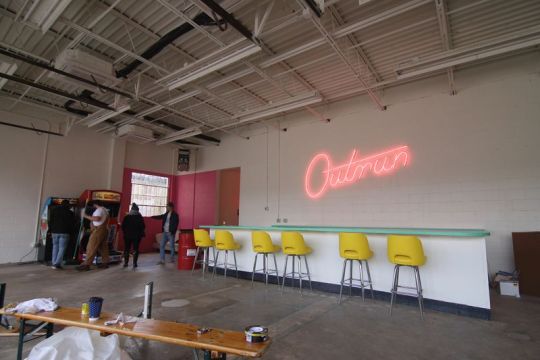
Inside the forthcoming Outrun.
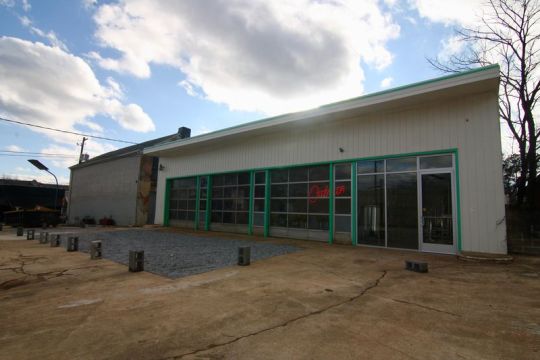
The former filling station’s patio affords mountain views.
Miller: “There’s so many new businesses coming into Stone Mountain. It’s potentially the next big area.”
Silva: “It’s not much different than Decatur 15 or 20 years ago. It could be another Decatur.”
Miller: “People always say, ‘You’re all the way out in Stone Mountain’—all the way out? Have you driven the 15-minute drive? I take Memorial [Drive] from the eastside, and there’s never traffic, no matter what time it is.”
Silva: “The reality is, a lot of people can’t afford to live in [Atlanta], and that’s fine. We’re trying to bridge the gap between the city and the severely underserved suburbs. We wanted to be in on it from the start, not the tail end. We want to be part of building the community up and the struggles that are part of that.”
(Whether the small city could handle an influx of new residents remains to be seen, however. More on that shortly.)
Miller: “There’s so much raw potential here. All it takes is a couple of people saying, ‘Hey, let’s try something.’ And I think that’s happening now. That’s how these towns get started. It’s going to be a whole new world.”
Linder, grinning near the entrance: “If you look at our street grid, it’s what Suwanee and all these new communities are trying to duplicate. We’ve had it for 100 years—now we’re just trying to fill in the gaps.”
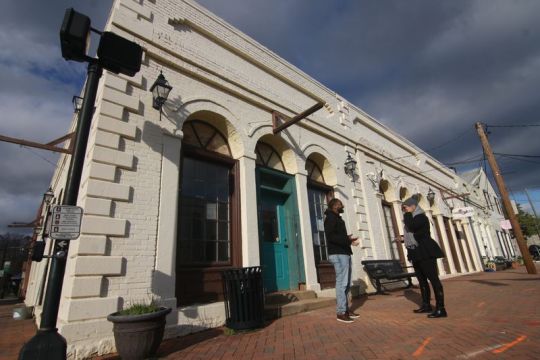
Jelani and Shani Linder, outside a forthcoming barbecue restaurant from a Decatur chef.
The residue
Beyond the brewery’s garage doors, the future patio for Adirondack chairs, and a towering magnolia stands an amenity that no other historic downtown in metro Atlanta can claim: the world’s largest piece of exposed granite, like the pate of a balding giant. Stone Mountain Park—the rock and private adventure grounds—is Georgia’s most popular tourist attraction (4 million annual guests strong) and one of the most-visited in the entire Southeast. There’s a 3,200-acre wonderland of trails and recreational sites around the mountain, all free to anyone who might, say, grab a pizza or beer in the village and walk or bike six blocks to the park.

Getty Images
The park is also home to the country’s largest shrine to the Confederacy, the enormous bas-relief sculpture of three Civil War leaders carved into the northern face, and a long, sullied history of Ku Klux Klan rallies and racist gatherings, including KKK parades as recently as the 1980s and an alt-right rally in 2016. The monadnock’s climbable, moonscape beauty includes a carving of Gen. Robert E. Lee as tall as a nine-story building—recently decried as the “largest shrine to white supremacy in the history of the world”—and the boulevard ringing it all bears the general’s name. The park was promptly closed last year when white supremacists attempted to rally during Atlanta’s Super Bowl. And though a group called Georgia Tourism Product Development Team has stepped in to help counter the reputation with reality, as the AJC reported last year, social media has played no small part in wedding the majority-black area with images of chanting, Confederate-flag waving white nationalists.
Sure, the symbols harken back to important American history. But they represent a glaring contrast to what’s becoming a more charming, diversified, and progressive former railroad village just beyond the park gates, where a wave of private investment promises to turn dead storefronts into a more organic type of attraction.
“This growth was bound to happen,” says Dorian DeBarr, Decide DeKalb Development Authority’s interim president. “As investors educated themselves and took an opportunity to actually experience what the village has to offer, it was a no-brainer.”
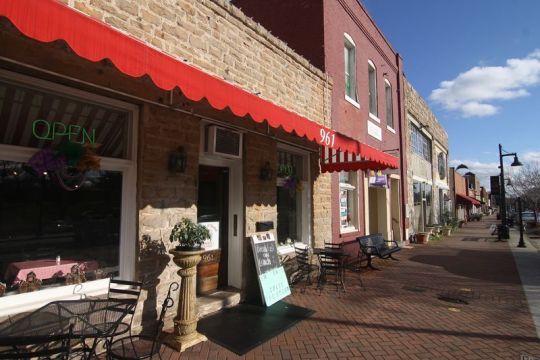
Main Street scenes today.

More broadly, DeKalb saw a surge of capital investment in 2019 to more than $1.1 billion—eight times the previous year—and growth as an entertainment industry destination, with productions as disparate as Dolly Parton Presents, Watchmen, Bad Boys 3, and Jumanji: The Next Level filming nearby. The mountain itself, of course, was immortalized in Dr. Martin Luther King Jr.’s most iconic speech, and this village of less than two square miles is where TV, music, and film superstar Donald Glover grew up.
So the contrast runs deep, like the granite. And for some, it stings.
“When you look at South DeKalb as a whole, it’s majority black, so you have to take that into consideration,” says Alan Peterson, the city’s Downtown Development Director with the DDA. “The monument, it’s state-owned. It’s history. It happened. There’s nothing we can do about it, and we’re just trying to move forward.”
The decline
Linder estimates that, as of a few years ago, between 60 and 70 percent of the early 20th century storefronts along Stone Mountain’s Main Street were vacant. Which makes a scathing Facebook review of the “ghost town” village, deposited on the city government’s page in 2016, no surprise:
“Only a few businesses remain and I can’t for the life of me understand how they are sustaining,” wrote one unimpressed patron. “The look on tourist faces when they visit downtown varies from shear surprise [sic], to disappointment and all-out disgust.”
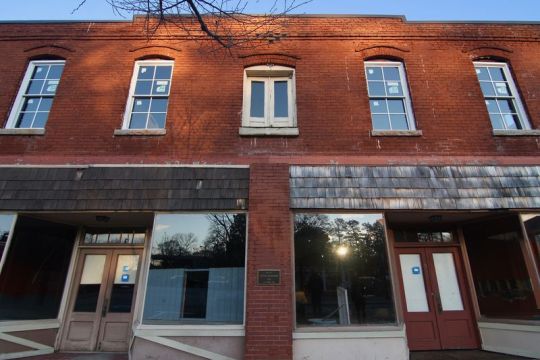
The vacant, circa-1905 Stone Mountain Inn building is located down the block from most recent retail activity.
That description conflicts with the bustling hub the village used to be. During Reconstruction, the Main Street area sprang into a center of tourism and industry hinged on quarrying. Local granite was shipped across the world, used in Tokyo’s Imperial Hotel, the Panama Canal, and in at least one building in almost every state in the U.S., including in the foundation of the Lincoln Memorial.
When the grounds around the mountain operated as a less-commercialized state park, the village was where tourists came for lunch, souvenirs, even a store that peddled butterflies, often riding a train that connected the two attractions. The state still owns the mountain but is leasing commercial operations for at least the next quarter-century to Norcross-based Herschend Family Entertainment, which owns or operates many other themed tourist hubs, such as Dollywood in Tennessee. The privatization deal began in 1988, and longtime locals say the village’s vibrancy soon changed, as the park’s main entrance was shifted to a U.S. Highway 78 exit, the village train ceased, and visitors began skirting the old town.
“I mean, they’re in business—nobody can blame [Herschend] for trying to keep the business in the park,” says Rory Webb, co-owner of Main Street bistro Stone Mountain Public House, who lives in a historic village house nearby. “But when they did all that, they virtually strangled the town. And I think a lot of the businesses weren’t willing or able to change with the times, to morph.”
Another struggle has been the misperception of rampant crime.
Business owners and longtime residents say two or three police officers from the city’s small department are seen patrolling the city’s 1.7 miles at most times, lending a sense of quietude—a bubble, even. Stone Mountain Police Department statistics show violent crime rates in 2019 at four per every 1,000 residents—or about 1/6 of the national average. An average of 21 property crimes, however, were reported per month last year, so it’s relatively safe but not exactly Mayberry.
“The worst thing is, a lot of people hear ‘Stone Mountain,’ and they think of unincorporated Stone Mountain,” says Webb. “You turn the news on, and there’s a stabbing or shooting in Stone Mountain, but you look, and it’s the DeKalb police, not inside the village.”
“It’s frustrating,” the DDA’s Peterson concurs. “We’re a small city, and our police force does a great job.”

The Main Street DIY crafts hub Stillwell’s Emporium, decorated for the village’s Mardi Gras parade in February.
Back on the walking tour, the Linders lead the way into a CBD retailer that opened next to the new pizza parlor in January, The Rose & Hemp. Behind the counter, founder Scott Koester says he and his wife, with a baby on the way, traded a 1,250-square-foot East Lake bungalow for a house they bought more than three times that size outside the village’s limits. He plans to live there for decades.
Koester was easily sold on the business location, he says, after parking across the street one day—in a lot where a free, open-container Friday music series, Tunes by the Tracks, will happen again this spring—and taking one look at Main Street’s bones.
“I can’t speak to the past, because I don’t know, I haven’t been here,” says Koester. “But it seems like a lot of people are coming together, to work together and make this a place people want to come.”
Directly above the shop, Lauren Godfrey and Ebonee Thompson, two friends and tech-company coworkers, are putting the finishing touches on the city’s first large coworking space, C3 Village, a sort of warmer WeWork with endearingly creaky floors and a lounge designed to resemble a Friends set. Like the brewers, CBD entrepreneur, and many others, they spoke of building a village of business allies and not competitors, each boat rising with a tide.
“Look, I’m a black girl from Florida, she’s a white girl from Georgia, and I think that it speaks to the story that people from completely different backgrounds can come together and create something so magical, something so passionate,” says Thompson, whose background in tourism has also landed her a deal to run the city’s new social media campaign. “That speaks volumes to what this community can do.”

Thompson and Godfrey, in the circa-1940 space they’ve renovated themselves into a coworking hub.
The upswing
As part of the city’s refined pitch to more investors, Peterson says the DDA is in the process of tabulating how much private investment—hundreds of thousands, at least—Stone Mountain has recently seen.
In January, the city inked a $155,000 contract with Atlanta architecture and engineering firm Pond to create a new downtown masterplan. Expected to be ready by August, the plan will aim to boost village esthetics and channel area visitors in from main arteries (by way of enhanced signage, as a starting point). Changes could also include additional bike lanes and green space meant to build off cyclist traffic that the popular PATH trail brings. A current city motto—“Atlanta’s Mountain Town”—is destined for the Dumpster, Peterson says.
Beyond the buildouts for forthcoming businesses, the makings of a buzzy, urban-style place are already here, headed by a diverse set of proprietors: a bike shop, arts center, theater, makers studio, antique shops, health store, new coffee house Gilly Brew Bar, event center and music studio 5380 Studios, a pie shop, and longstanding eateries like Public House, Sweet Potato Cafe (in a funky bungalow off Main Street), and the stalwart Wells Cargo Cafe.
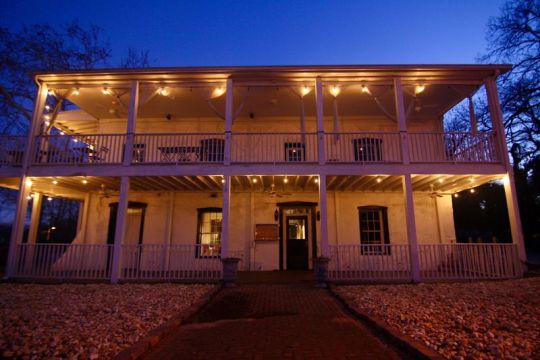
Gilly’s coffee house occupies the 1834 former home of Stone Mountain’s first mayor, where both Union and Confederate casualties were hospitalized during the Civil War. A new restaurant is also planned.
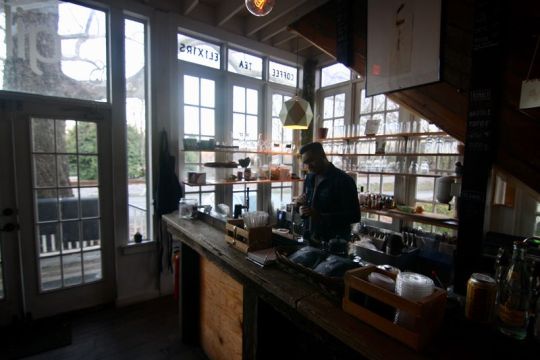
“I mean, Stone Mountain is one of the largest attractions in the Southeast,” says Gilly barista Ivan Solis. “It’s kind of crazy how many people go there, but don’t come here. It’s kind of weird.”
Around the corner from the brewery in a circa-1900 brick building, however, could be the most-hyped new attraction on the walking tour: 13th Colony BBQ, a venture by Stone Mountain native Jonathan Hartnett of Decatur’s Las Brasas. That’s expected to open in April, on the corner opposite Stoned Pizza Kitchen, lending another commercial jolt to the village’s nucleic intersection.
“People love to see old historic buildings from the early 1900s repurposed,” says David Downs, a Realtor with Keller Knapp Realty, who fell for the village during group cycling rides from Decatur—and who’s bought and renovated three Main Street buildings in recent years. “You can’t build history.”
Housing outlook
As a tangerine sunset flares over the pines, the walking tour concludes at a development called Hearthstone Park that could lend a glimpse at Stone Mountain Village’s residential future—where the Linders both own a home and, as real estate agents, are actively selling others.
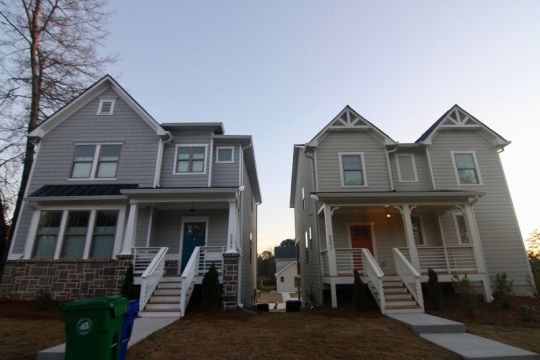



Jelani, who’s been a village resident and homeowner since 2006, says Hearthstone marks the city’s first new housing development in nearly 20 years. Thirty-four standalone houses are planned around a central park, each with three bedrooms and mountain views. A starting price of $285,000 buys 1,500 square feet and change, while the $350,000 range gets a finished basement and 2,400 square feet.
“This is a half-million dollar product intown, at least,” Jelani notes in the model unit’s living room. “It’s something for people getting pushed out, or empty-nesters.”
For existing housing stock, Neighborhood Scout pegs the median Stone Mountain home value at just $127,724, with a majority built between 1970 and 1999. Per recent sales records, the low $200,000s buys a livable three-bedroom, midcentury bungalow within a few blocks of the village.
But the renovated classics near Main Street are harder to come by, often trading by word of mouth before listing. “When older homes do come on the market,” says Shani, “they go like that—snap!”
Census estimates show the city’s population has inched up by less than 500 people since 2010. And Jelani says infill opportunities in city limits are limited. So one can’t help but wonder, should the droves come seeking relatively affordable housing in a unique, walkable, outdoorsy setting—amidst a metro expected to ballon with 3 million more people by 2050—where they all might fit.
But that’s a matter for another, more sober day.
It being Friday night, the Public House—the village’s de facto Cheers—comes alive with clinking glasses, ragtime music, and karaoke crowds. In the back, huddled around a booth, Webb the co-owner describes how the village retains an overtly friendly, come-on-over southernness without the yesteryear stigma. He points to a crowd that’s diverse—and by all indications, defiantly proud of it.
“You either fall in love with the village, or you don’t,” says Webb. “And if you do, you got to live here. It’s the best hidden gem in Georgia.”
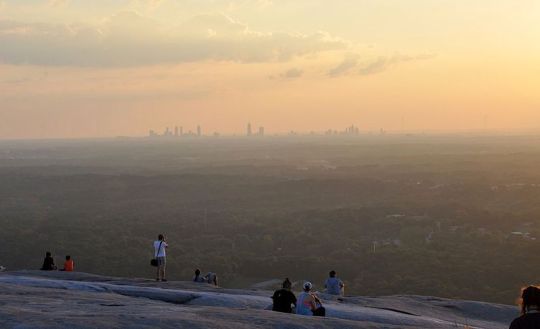
From the mountain’s summit, with downtown and Midtown Atlanta beyond, and the village below.
source https://atlanta.curbed.com/2020/2/28/21128454/stone-mountain-village-park-atlanta-restaurants-brewery-main-street
0 notes
Text
July 8 2018 London and Windsor
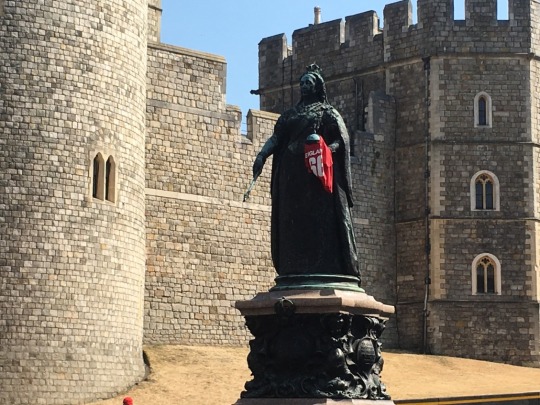
Today our guide picked us up at the hotel and drove us out to Windsor to visit Windsor Castle, one of Queen Victoria’s favorite residences. According to Wikipedia:
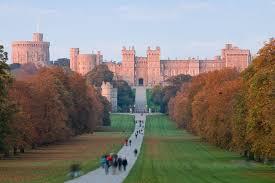
“Windsor Castle is a royal residence at Windsor in the English county of Berkshire. It is notable for its long association with the English and later British royal family and for its architecture.
The original castle was built in the 11th century after the Norman invasion of England by William the Conqueror. Since the time of Henry I, it has been used by the reigning monarch and is the longest-occupied palace in Europe. The castle's lavish early 19th-century State Apartments were described by the art historian Hugh Roberts as "a superb and unrivaled sequence of rooms widely regarded as the finest and most complete expression of later Georgian taste". Inside the castle walls is the 15th-century St George's Chapel, considered by the historian John Martin Robinson to be "one of the supreme achievements of English Perpendicular Gothic" design.
Originally designed to protect Norman dominance around the outskirts of London and oversee a strategically important part of the River Thames, Windsor Castle was built as a motte-and-bailey, with three wards surrounding a central mound. Gradually replaced with stone fortifications, the castle withstood a prolonged siege during the First Barons' War at the start of the 13th century.
Henry III built a luxurious royal palace within the castle during the middle of the century, and Edward III went further, rebuilding the palace to make an even grander set of buildings in what would become "the most expensive secular building project of the entire Middle Ages in England". Edward's core design lasted through the Tudor period, during which Henry VIII and Elizabeth I made increasing use of the castle as a royal court and center for diplomatic entertainment.
Windsor Castle survived the tumultuous period of the English Civil War, when it was used as a military headquarters by Parliamentary forces and a prison for Charles I. At the Restoration of the monarchy in 1660, Charles II rebuilt much of Windsor Castle with the help of the architect Hugh May, creating a set of extravagant Baroque interiors that are still admired.
After a period of neglect during the 18th century, George III and George IV renovated and rebuilt Charles II's palace at colossal expense, producing the current design of the State Apartments, full of Rococo, Gothic and Baroque furnishings. Queen Victoria made a few minor changes to the castle, which became the center for royal entertainment for much of her reign.
Windsor Castle was used as a refuge by the royal family during the Luftwaffe bombing campaigns of the Second World War and survived a fire in 1992. It is a popular tourist attraction, a venue for hosting state visits, and the preferred weekend home of Elizabeth II.
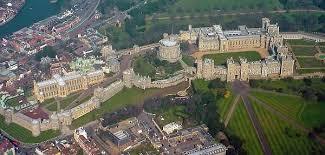

I have always been a fan of Queen Victoria, and particularly after we began watching the PBS Masterpiece series “Victoria” . According the the official UK website:
“Queen Victoria was born at Kensington Palace, London, on 24 May 1819. She was the only daughter of Edward, Duke of Kent, fourth son of George III. Her father died shortly after her birth and she became heir to the throne because the three uncles who were ahead of her in the succession - George IV, Frederick Duke of York, and William IV - had no legitimate children who survived.
Warmhearted and lively, Victoria had a gift for drawing and painting; educated by a governess at home, she was a natural diarist and kept a regular journal throughout her life. On William IV's death in 1837, she became Queen at the age of 18.

Queen Victoria is associated with Britain's great age of industrial expansion, economic progress and, especially, empire. At her death, it was said, Britain had a worldwide empire on which the sun never set.

In the early part of her reign, she was influenced by two men: her first Prime Minister, Lord Melbourne, and then her husband, Prince Albert, whom she married in 1840. Both men taught her much about how to be a ruler in a 'constitutional monarchy', in which the monarch had very few powers but could use much influence.

Albert took an active interest in the arts, science, trade and industry; the project for which he is best remembered was the Great Exhibition of 1851, the profits from which helped to establish the South Kensington museums complex in London.
Her marriage to Prince Albert produced nine children between 1840 and 1857. Most of her children married into other Royal families of Europe.
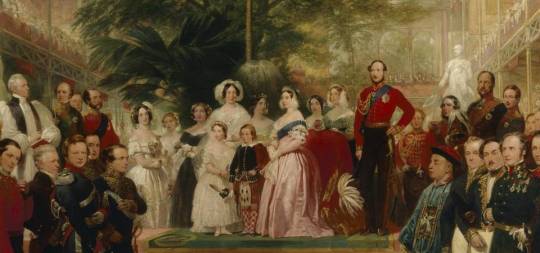
Victoria bought Osborne House (later presented to the nation by Edward VII) on the Isle of Wight as a family home in 1845, and Albert bought Balmoral in 1852.
Victoria was deeply attached to her husband and she sank into depression after he died, aged 42, in 1861. She had lost a devoted husband and her principal trusted adviser in affairs of state. For the rest of her reign she wore black.

Until the late 1860s she rarely appeared in public; although she never neglected her official Correspondence, and continued to give audiences to her ministers and official visitors, she was reluctant to resume a full public life.
She was persuaded to open Parliament in person in 1866 and 1867, but she was widely criticized for living in seclusion and quite a strong republican movement developed.
Seven attempts were made on Victoria's life, between 1840 and 1882 - her courageous attitude towards these attacks greatly strengthened her popularity.
With time, the private urging of her family and the flattering attention of Benjamin Disraeli, Prime Minister in 1868 and from 1874 to 1880, the Queen gradually resumed her public duties.
In foreign policy, the Queen's influence during the middle years of her reign was generally used to support peace and reconciliation. In 1864, Victoria pressed her ministers not to intervene in the Prussia-Denmark war, and her letter to the German Emperor (whose son had married her daughter) in 1875 helped to avert a second Franco-German war.”
To read more about Victoria (and there IS much more), visit this website:
https://www.royal.uk/queen-victoria
Another way to learn more, and for you it might be more enjoyable, as it has been for us, is to watch the PBS series starring Jenna Coleman, seen below, as the queen and Tom Hughes as Prince Albert.




It’s a wonderful series and we’re waiting with “baited breath” for the next installment, the third season. If you haven’t seen it, you might want to watch this trailer to get a glimpse of it:
https://www.pbs.org/video/masterpiece-victoria-official-trailer/
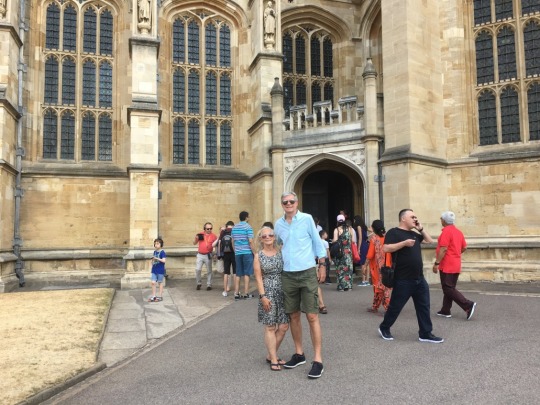
Our guide took these photos of us in front of the castle’s chapel, St. George’s, where Prince Harry and Meghan Markle were married in May.
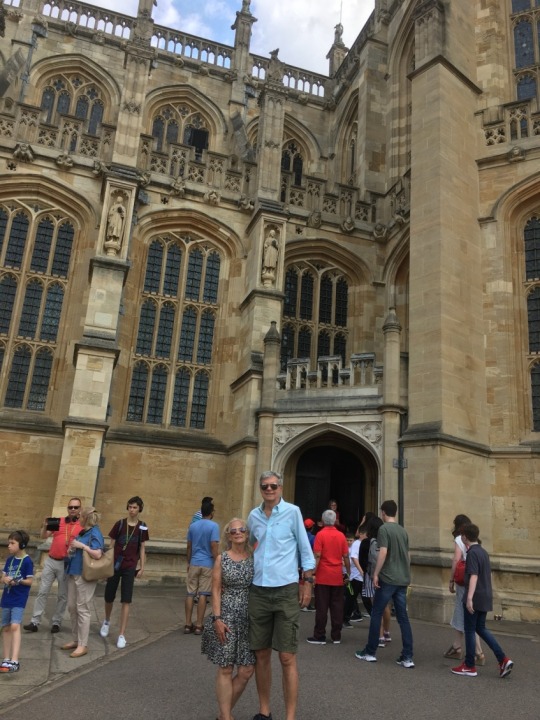
Here are five interesting facts about the chapel from its website:
“1. The term chapel is deceptive, as St George’s is more like a cathedral in size. It occupies a large part of the Lower Ward of Windsor Castle and has been hailed as one of the finest displays of Gothic architecture in Britain today.
2. Although the chapel is known as St George’s, it is dedicated to the Virgin Mary and Edward the Confessor as well as England’s patron saint, according to the chapel’s website. King Edward III founded the Most Noble Order of the Garter in 1348 and in the same year founded the College of St George ‘to the praise of God and in honour of Blessed Mary, St George and St Edward’.
3. Construction of the chapel began in 1475 by Edward IV. It was completed in 1528 under the reign of Henry VIII.
4. The chapel is the spiritual home of the Order of the Garter, an order of chivalry established in 1348 by Edward III. Every June, the Garter Day procession takes place at Windsor Castle, accompanied by a marching band and Officers of the Order, who attend alongside the Queen and the royal family wearing grand ceremonial dress.
5. It’s an important place for pilgrimage. Today, only Henry VI’s tomb remains among the early pilgrim sites in the south-east corner of the chapel. “

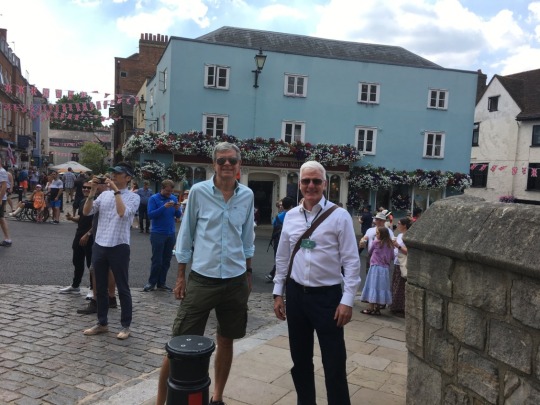
After touring the castle we briefly went into the village of Windsor for a peak, then headed out to Carnarvon for lunch.
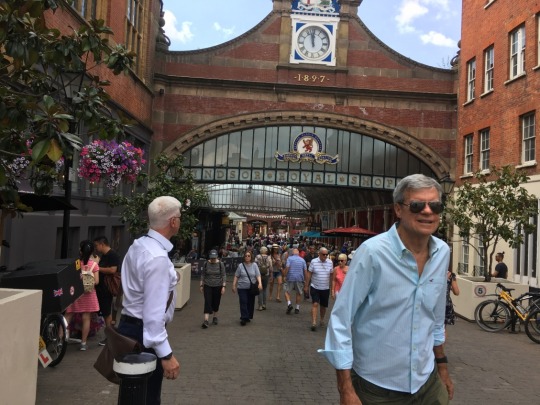
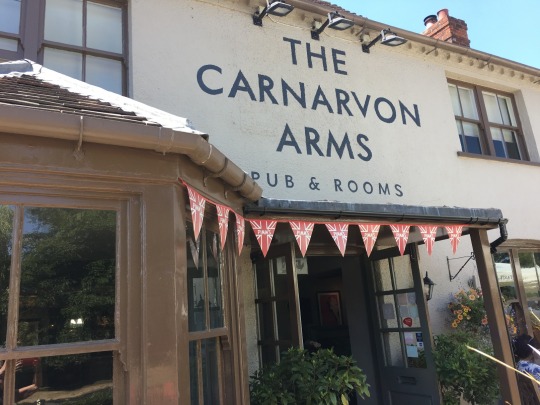
The restaurant our guide chose was close to Highclere Castle, the setting for the much-beloved ITV series “Downton Abbey” and the next stop on our tour.
From the Carnarvon Arms website:
“Steeped in history and a favorite among those looking to indulge in country pursuits, the Carnarvon has a rich heritage of noble service. Originally a coaching inn built some 200 years ago to provide a pit-stop for travelers to nearby Highclere Castle, the stunning set of ITV’s blockbuster drama, Downton Abbey, the Carnarvon continues to offer a warm welcome for those looking to explore this beautiful area of Berkshire.
With the North Wessex Downs right on our doorstep, we’re the ideal starting point to enjoy all that this stunning Area of Outstanding Natural Beauty has to offer, including ancient woodland and downs, famed as the inspiration for the classic novel, Watership Down.”
The ambiance and the food were both very good and revived us for our next adventure visiting Highclere Castle.
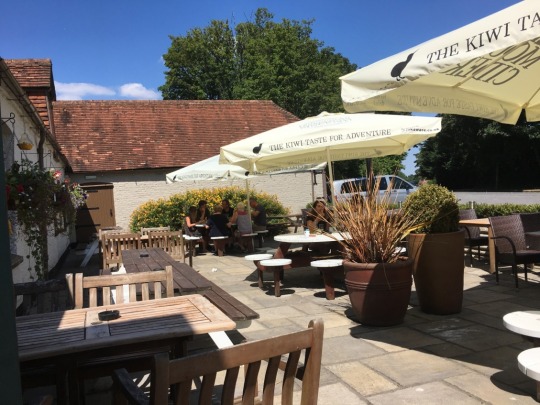
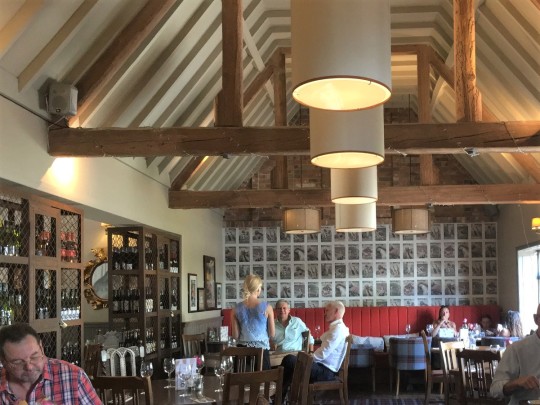
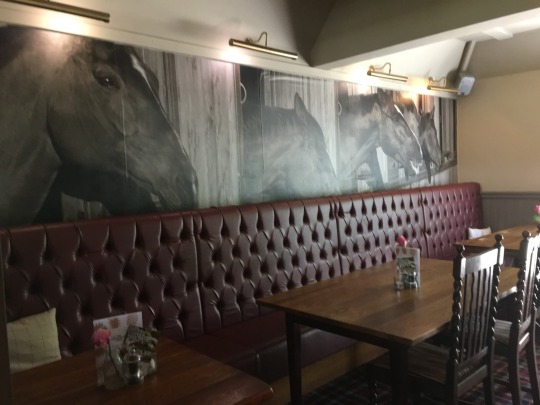

If you have never seen “Downton Abbey” and you like history and drama, you might want to consider “giving it a look-see”. We watched all six seasons twice. We were thrilled to be able to visit the castle, the current home of the Eighth Earl of Carnarvon and his real family, whose ancestors were the inspiration for the series.

From the Highclere Castle website about the book, which I, of course, purchased in the castle’s bookstore, and which led to the series:
“Lady Catherine and the Real Downton Abbey tells the story of the beautiful American girl who lived at Highclere Castle, the setting for Julian Fellowes' award winning drama "Downton Abbey". Glamorous and wealthy, Catherine became the toast of London society and married the son of the 5th Earl of Carnarvon, Lord Porchester, or 'Porchey', as he was known.

At just 19, Catherine had to learn how to organize and host the lavish banquets and weekend house parties that Porchy so loved. She found herself suddenly in charge of the more than eighty staff working at Highclere Castle. One of the first challenges they both had to face was to save Highclere Castle from being sold to pay enormous death duties for which they were liable after the death of the 5th Earl of Carnarvon.
As the decade of the 1930’s developed their marriage sadly did not survive and Catherine moved to London. The book follows the lives and challenges of upstairs and downstairs as World War two became imminent. Highclere was transformed into a home for evacuee children and the whole estate was turned over to the war effort to survive the German blockade and helped train allied soldiers.”



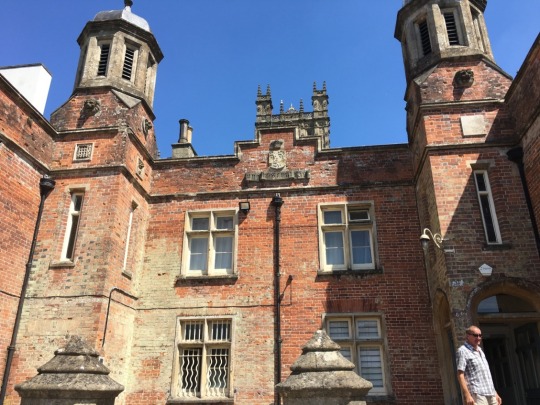
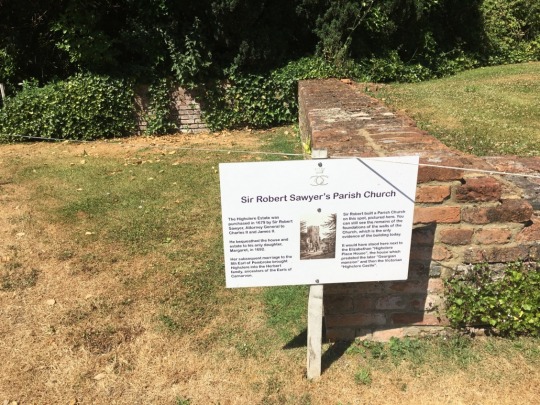

If you have never seen Downtown Abbey, and you like historical dramas, here is a photo and a link to the trailer of the first season to pique your interest:

https://www.youtube.com/watch?v=EOM3y4P8TEM
0 notes
Text
California Wildfires Burn Down Westworld Set as TV Stars Face Devastation and Loss
Now Playing
Best Performances: How Westworld's Jimmi Simpson Bridged the Man in Black and William
UPDATE: Sunday, Nov. 11, 1:30 p.m. PT: The California wildfires that destroyed the set of one show and came dangerously close to doing the same for another raged on into the weekend as Hollywood continued to grapple with the devastation.
The fires in Los Angeles and Ventura Counties have burned down the historic Western Town on the Paramount Ranch set where Westworld films and at one point were perilously close to the Agoura Hills mansion where The Bachelor and The Bachelorette are filmed before it was able to be saved. At least 23 people have died with many more missing.
Variety reported Friday that the Western set in Agoura Hills that has served as a filming location for shows including Weeds and Dr. Quinn, Medicine Woman burned. Westworld films its Main Street scenes at the same locale.
The Bachelor creator Mike Fleiss also shared a photo of smoke billowing over the hills with the caption "Pray for Malibu-- and #TheBachelor Mansion..." ABC executive Rob Mills shared Fleiss' tweet, adding "Thinking of the people of Malibu and yes #TheBachelor Mansion is in grave danger as well."
The house is owned by the Haradan family, who live there most of the year and move out when the show is filming. Although initial reports from Friday suggested that the mansion had caught fire, it has since been confirmed that the famous home survived the blaze unscathed, while the house next door to it was completely destroyed. Production of the series was not at the location when the fire reached the manor; The Bachelor is instead shooting in Portugal.
Many Hollywood notables were directly affected too. There was good news for the Sheen family this weekend after Martin Sheen was found safe. On Friday, his son Charlie Sheen asked his Twitter followers for help after he was not able to get in touch with The West Wing star or his mother. However, the actor was soon after located by local news station Fox 11, and he was able to update his concerned children that the two had managed to evacuate their Malibu home safely, although they feared their home might not be there when they return to it.
Director Guillermo del Toro also reported being successful at rescuing some of his most important filmmaking mementos from his so-called "Bleak House" after evacuating the residence and fearing the items may be lost.
Others have not been as fortunate. Actress Shannen Doherty revealed Saturday that the home she was married in, which she'd taken refuge in after her father's passing, was destroyed in the fire. And Real Housewives of Beverly Hills star Camille Grammer shared a devastating image of her home as it was destroyed by fire.
Musician Robin Thicke and actor Gerard Butler also reported losing their homes as the fire spread, but both were able to escape to safety before the flames reached them.
Fellow reality star Kim Kardashian fled her home, and, while waiting for news on its condition, her family rallied to help provide needed supplies for first responders. Meanwhile, the family of small screen star Rob Lowe, whose neighborhood was devastated by mudslides in early 2018 and converted his home into a firefighter refuge during rescue efforts, also participated in fire evacuation efforts and assisted first responders.
Amid the chaos and confusion on social media, actor James Woods devised a series of hashtags meant to help organize those who were tweeting for help finding their missing loved ones into one thread. The gesture has drawn praise from some of his more vocal ideological opposites in Hollywood, including Alyssa Milano and Patton Oswalt, who both praised him for his good work.
The Woolsey Fire and Camp Fire of southern Calif. has forced a mandatory evacuation of thousands of homes, and over 35,000 acres have burned, including the entire city of Paradise. Calif., according to The Washington Post.
For suggestions on how to help those affected by the wildfires, visit KABC.
Source: https://www.tvguide.com/news/california-fires-westworld-set-martin-charlie-sheen/?rss=breakingnews
0 notes
Text
RALEIGH, N.C | Wind, rain, surge, flood: Hurricane Florence could hit hard
New Post has been published on https://www.stl.news/raleigh-n-c-wind-rain-surge-flood-hurricane-florence-could-hit-hard/168991/
RALEIGH, N.C | Wind, rain, surge, flood: Hurricane Florence could hit hard
RALEIGH, N.C — As mandatory evacuations begin for parts of three East Coast states, millions of Americans have been preparing for what could become one of the most catastrophic hurricanes to hit the Eastern Seaboard in decades.
Hurricane Florence’s top winds dipped to 130 mph (215 kph) Tuesday morning, but it remains a Category 4 storm and is expected to approach the most-damaging Category 5 status as it slows strengthens over very warm ocean water off the coast of North and South Carolina.
The center of the massive storm is then forecast to meander Thursday, Friday and Saturday over a stretch of coastline saturated by rising seas, inundating several states with rainfall and triggering life-threatening floods.
“Please be prepared, be careful and be SAFE!” President Donald Trump tweeted Monday evening.
South Carolina’s governor ordered the state’s entire coastline evacuated starting at noon Tuesday and predicted that 1 million people would flee as highways reverse directions. Virginia’s governor ordered a mandatory evacuation for some residents of low-lying coastal areas, while some coastal counties in North Carolina have done the same.
North Carolina Gov. Roy Cooper said his state is “in the bullseye” and urged people to “get ready now.”
The very center of that bullseye may be Camp Lejeune, the sprawling Marine Corps training base. Tuesday’s 7-day rainfall forecast showed 20 inches or more falling there, part of a wide swath of rainfall that could total ten inches or more over much of Virginia and drench the nation’s capital. Some isolated areas could get 30 inches, forecasters said.
Florence could hit the Carolinas harder than any hurricane since Hazel packed 130 mph (209 kph) winds in 1954. That Category 4 storm destroyed 15,000 buildings and 19 people in North Carolina.
In the six decades since then, many thousands of people have moved to the coast.
The storm’s first effects were already apparent on barrier islands as dangerous rip currents hit beaches and seawater flowed over a state highway — the harbinger of a storm surge that could wipe out dunes and submerge entire communities.
Watches were already in effect Tuesday for a storm surge that could reach up to 12 feet at high tide on a stretch from Cape Fear to Cape Lookout in North Carolina, forecasters said. A hurricane watch was in effect for Edisto Beach, South Carolina, to Virginia’s southern border, and the first hurricane-force winds arriving late Thursday.
For many people, the challenge could be finding a safe refuge: If Florence slows to a crawl just off the coast, it could bring torrential rains all the way into the Appalachian mountains and as far away as West Virginia, causing flash floods, mudslides and other dangerous conditions in places that don’t usually get much tropical weather.
“This is going to produce heavy rainfall, and it may not move very fast. The threat will be inland, so I’m afraid, based on my experience at FEMA, that the public is probably not as prepared as everybody would like,” said Craig Fugate, former director of the Federal Emergency Management Agency.
National Hurricane Center Director Ken Graham also warned that Florence is expected to linger once onshore, downing trees, knocking out electricity and causing widespread flooding.
The storm’s potential path also includes half a dozen nuclear power plants, pits holding coal-ash and other industrial waste, and numerous hog farms that store animal waste in massive open-air lagoons.
Airlines, including American, Southwest, Delta and JetBlue, have begun letting affected passengers change travel plans without the usual fees.
A warm ocean is the fuel that powers hurricanes, and this area of the ocean is seeing temperatures peak near 85 degrees (30 Celsius), hurricane specialist Eric Blake wrote. And with little wind shear to pull the storm apart, Florence’s hurricane-strength winds were expanding, reaching 40 miles (64 kilometers) from the eye of the storm.
“Unfortunately, the models were right. Florence has rapidly intensified into an extremely dangerous hurricane,” Blake wrote Monday evening, predicting that the hurricane’s top sustained winds would approach the 157 mph (253 kph) threshold for a wost-case Category 5 scenario. Tuesday morning’s forecast still supports this, the National Hurricane Center said.
By 8 a.m. Tuesday, Florence was centered about 950 miles (1,530 kilometers) east-southeast of Cape Fear, North Carolina, and moving west-northwest at 15 mph (24 kph). Its center will move between Bermuda and the Bahamas on Tuesday and Wednesday and approach the coast of South Carolina or North Carolina on Thursday.
Two other storms were spinning in the Atlantic as the 2018 hurricane season reaches its peak. Isaac became a tropical storm again approaching the Caribbean, while Hurricane Helene was veering northward, no threat to land.
In the Pacific, Olivia became a tropical storm again on a path to hit the Hawaiian islands early Wednesday.
South Carolina Gov. Henry McMaster said an estimated 1 million people would be fleeing his state’s coast, with eastbound lanes of Interstate 26 heading into Charleston and U.S. 501 heading into Myrtle Beach reversed to ease the exodus.
Virginia Gov. Ralph Northam’s evacuation order applies to about 245,000 people, including parts of the Hampton Roads area and Eastern Shore.
Liz Browning Fox was planning to ride out the storm nevertheless on the Outer Banks. She said her house, built in 2009 in Buxton, North Carolina, is on a ridge and built to withstand a hurricane. But even the most secure homes could be surrounded by water, or penetrated by wind-launched debris.
“You never know, there could be tree missiles coming from any direction,” she said. “There is no way to be completely safe.”
But, she added, she’s not sure whether going inland would be much safer: “I don’t know where to go from here.” ___ Associated Press writers Seth Borenstein in Washington; Jennifer Kay in Miami; Jeffrey Collins and Meg Kinnard in Columbia, South Carolina; and Jeff Martin in Atlanta contributed to this report.
By Associated Press, Associated Press
#Coast states#Eastern Seaboard#Flood#Hurricane Florence#north carolina news#Rain#raleigh#surge#TodayNews#wind
0 notes